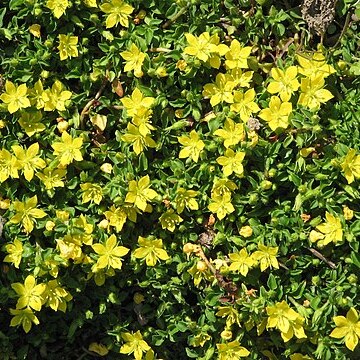Stems prostrate to ascending, simple or branched proximally, 1-3 dm, pubescent; rhizomes very slender; bulblets absent. Leaves opposite or sometimes alternate near apex of stem; petiole 0.5-1.5 cm, pubescent; blade orbiculate to ovate or deltate, 1.5-4 × 0.7-2 cm, base rounded to truncate, slightly decurrent, margins entire, plane, pubescent, apex acute to obtuse, surfaces punctate, sparsely pubescent; venation pinnate-arcuate. Inflorescences axillary in distal leaves, solitary flowers. Pedicels 0.2-0.8 cm, pubescent. Flowers: sepals 5, calyx not streaked, 5-9 mm, pubescent, lobes narrowly lanceolate, margins thin; petals 5, corolla yellow, not streaked, rotate, 5-9 mm, lobes with margins entire, apex acute to rounded, stipitate-glandular; filaments connate, shorter than corolla; staminodes absent. Capsules 2.5-3 mm, not punctate, pubescent distally. 2n = 18, 20, 22 (all Asian).
A slender, little branched herb which lies on the ground. The stem is angular and brown hairy. The plant is 5-10 cm long and the leaves are 4-7 mm by 3-5 mm. The leaves occur opposite one another. Flowers are singly in the axils of leaves. They droop.

